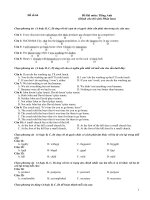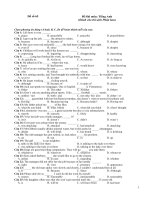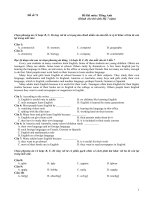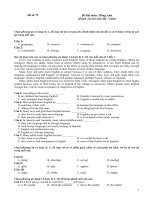Đáp án đề thi thử đại dọc số 15
Bạn đang xem bản rút gọn của tài liệu. Xem và tải ngay bản đầy đủ của tài liệu tại đây (113.06 KB, 6 trang )
TRƯỜNG THPT CHUYÊN LÊ QUÝ ĐÔN ĐỀ THI THỬ ĐẠI HỌC LẦN 2- NĂM HỌC 2009-2010
(Đề thi gồm 06 trang, 80 câu trắc nghiệm) Môn: Tiếng Anh - Thời gian: 90 phút
Phonetics:
Question 1: A. foreword B. preface C. index D. mature
Question 2: A. character B. procedure C. sophomore D. plagiarize
Question 3: A. photography B. inaccurate C. eligible D. originate
Question 4: A. official B. delicate C. opponent D. diploma
Question 5: A. extracurricular B. auditorium C. recommendation D. cooperation
Choose the best answer:
Question 6: Workers who do not obey the safety regulations will be _______ immediately.
A. refused B. rejected C. disapproved D. dismissed
Question 7: I’m sorry, teacher. I’ve _______ my homework on the bus.
A. forgotten B. let C. missed D. left
Question 8: She _______ for hours. That’s why her eyes are red now.
A. cried B. has been crying C. has cried D. was crying
Question 9: TOEFL stands for _______ .
A. Teaching of English like a Foreign Language B. Testing of English as a Foreign Language
C. Teaching of English as a Foreign Language D. Test of English as a Foreign Language
Question 10: He did not share his secrets with many people but he _______ in her.
A. confessed B. consented C. confided D. revealed
Question 11: He drove fast and arrived an hour _______ of schedule.
A. in advance B. ahead C. in front D. on account
Question 12: The area was _______ by that storm, wasn’t it ?
A. attacked B. struck C. beaten D. infected
Question 13: An architect planning a new should always _______ in mind his client’s needs.
A. carry B. bear C. remember D. take
Question 14: My sister supports her living by _______ of evening jobs.
A. means B. ways C. methods D. measures
Question 15: He always did well at school _______ having his early education disrupted by illness.
A. apart from B. in spite of C. in addition to D. because of
Question 16: In ______ people, the areas of the brain that control speech are located in the left hemisphere.
A. mostly B. most C. almost D. most of
Question 17: Stars shine because of _______ produced by the nuclear reactions taking place within them.
A. the amount of light and heat is B. which the amount of light and heat
C. the amount of light and heat that it is D. the amount of light and heat
Question 18: ________ is not clear to researchers.
A. Why did dinosaurs become extinct B. Why dinosaurs became extinct
C. Did dinosaurs become extinct D. Dinosaurs became extinct
Question 19: _______ no two people think exactly alike, there will always be disagreement, but disagreement should
not always be avoided; it can be healthy if handled creatively.
A. When B. While C. Unless D. Because
Question 20: Drinking water ________ excessive amounts of fluorides may leave a stained or mottled effect on the
enamel of teeth.
A. containing B. including C. made up of D. composed of
Trang 1/6- Mã đề thi 135
Question 21: One theory of the origin of the universe is ________ from the explosion of a tiny, extremely
dense fireball several billion years ago.
A. when forming B. the formation that C. that it formed D. because what formed
Question 22: ________ at the site of a fort established by the Northwest Mounted Police, Calgary is now one of
Canada’s fastest growing cities.
A. Built B. It is built C. To build D. Having built
Question 23: Harry’s new jacket doesn’t seem to fit him very well. He ________ it on before he bought it.
A. must have tried B. should have tried C. needn’t have tried D. might have tried
Question 24: Today all five species of rhinos are perilously close ________ extinction.
A. with B. to C. of D. for
Question 25. My neighbor is ________ ; he is always showing that he never cares about his bad behavior.
A. barefaced B. grim-faced C. faceless D. face-saving
Question 26: Why don’t you ask the man where ________to eat?
A. he would rather B. would he like C. he would like D. he feels like
Question 27: Jack: “Many happy returns, Jill.”
Jill: “________”
A. Thank you. B. Good luck! C. Really? When? D. Thanks. The same to you!
Question 28: It is necessary that one ________ a lawyer before signing an important contract.
A. consulted B. consult C. consults D. has consulted
Question 29: Linda: “I’m getting married next week.”
Janet: “ ________”
A. Good luck! B. Congratulations! C. My best regards! D. Bravo!
Question 30: Smith: “I’m afraid I can’t come with you.”
John: “________”
A. What a shame! B. It’s shameful! C. Thank you D. I don’t think so
Question 31: She kindly offered to ________ me the way to the post office.
A. explain B. direct C. describe D. show
Question 32: The train was ________ by a heavy snowfall.
A. held off B. held out C. held back D. held up
Question 33: It was so quiet; you could have heard a ________ drop.
A. pin B. feather C. leaf D. sigh
Question 34: More than a billion people all over the world are ________ threat of desert expansion.
A. in B. under C. on D. with
Question 35. Can you see to these letters first, please? The others ________ answered immediately.
A. must be B. don’t have to be C. mustn’t be D. have to be
Blacken the letter A, B, C, or D on your answer sheet to show the underlined part that needs correction.
Question 36: The population of California more than doubled (A) during the period (B) 1940-1960, creating
problems in (C) road-building and provide (D) water for its arid southern section.
Question 37: Hard and resistant to (A) corrosion, bronze is traditionally (B) used in bell casting (C) and is the
material used widely most (D) for metal sculpture.
Question 38: In a microwave oven, radiation penetrates food and is (A) then absorbed primarily (B) by water
molecules, caused (C) heat to spread through the food (D).
Question 39: A liquid that might be a poor (A) conductor when pure (B) is often used to make (C) solutions that
readily transmits (D) electricity.
Trang 2/6- Mã đề thi 135
Question 40: By identifying (A) similar words or structures in different languages, we find evidence that those
languages are related (B) and may be derived (C) from same ancestor (D).
Choose the best answer:
Question 41: I remember someone giving me a rubber doll on my 10
th
birthday.
A. Someone is remembered giving me a rubber doll on my 10
th
birthday.
B. I am given a rubber doll on my 10
th
birthday by someone I remember.
C. On my 10
th
birthday, a rubber doll is remembered by someone giving me.
D. I remember being given a rubber doll on my 10
th
birthday.
Question 42: Mary exclaimed that the singer’s voice was so sweet.
A. “How sweet is the singer’s voice?” said Mary.
B. “What a sweet voice the singer has,” said Mary.
C. “How sweet voice the singer is,” said Mary.
D. “What a sweet voice the singer is,” said Mary.
Question 43: You should not keep bad company under any circumstances.
A. In no circumstances should you be friends with bad people.
B. Under no circumstances should you not keep bad company.
C. Under any circumstances shouldn’t you make friends with bad people.
D. In no circumstances should you keep your company because it is bad.
Question 44: Mr. Smith is very interested in our plan. I spoke to him on the phone last night.
A. Mr. Smith, who is very interested in our plan, I spoke to on the phone last night.
B. Mr. Smith, to whom I spoke on the phone last night, is very interested in our plan.
C. Mr. Smith is very interested in our plan to whom I spoke on the phone last night.
D. Mr. Smith, who I spoke on the phone last night, is very interested in our plan.
Question 45: “Thank you, John! See you again,” Jane said.
A. Jane said thank you John and see him again.
B. Jane thanked John and said see him again.
C. Jane thanked John and said goodbye to him.
D. Jane thanked John and saw him again.
Question 46: Although she was disabled, she was quite confident the first time she practiced this sport.
A. Though a disabled girl, she was quite confident the first time she practiced this sport.
B. Though she was unable to walk, but the first time she practiced this sport, she was quite confident.
C. In spite of being quite confident the first time she practiced this sport, she was disabled.
D. She was quite confident when practicing this sport for the first time despite she was a disabled girl.
Question 47: Unlike her friends, she disagreed strongly with the idea of moving abroad.
A. Her friends were in favor of the idea of moving abroad- that is why she disagreed strongly with them.
B. Different from her friends, she was opposed to the idea of moving abroad.
C. She disliked her friends, and didn’t support the idea of moving abroad.
D. She disagreed strongly with her friends, who came up with the idea of moving abroad.
Question 48: "Shall I make you a coffee?" the girl said to the man.
A. The girl wanted to make a coffee for the man.
B. The girl was asked to make a coffee for the man.
C. The girl promised to make a coffee for the man.
D. The girl offered to make a coffee for the man
Question 49: Impressed as we were by the new album, we found it rather expensive.
A. The new album was more expensive than we expected.
B. We were very impressed by the new album, but found it rather expensive.
C. We were not impressed by the new album at all because it looked rather expensive.
D. We weren’t as much impressed by the new album’s look as its price.
Trang 3/6- Mã đề thi 135
Question 50: The onset of the disease is shown by a feeling of faintness.
A. One feels faint if the disease is over.
B. A feeling of faintness signals the final stage of the disease.
C. The first sign of the disease is a feeling of faintness.
D. Faintness causes the disease.
Reading comprehension:
There is a common expression in the English language referring to a blue moon. When people say that
something happens “only once in a blue moon,” they mean that it happens only very rarely, once in a great while. This
expression has been around for at least a century and a half; there are references to this expression that date from the
second half of the nineteenth century.
The expression “a blue moon” has come to refer to the second full moon occurring in any given calendar
month. A second full moon is not called a blue moon because it is particularly blue or is any different in hue from the
first full moon of the month. Instead, it is called a blue moon because it is so rare. The moon needs a little more than 29
days to complete the cycle from full moon to full moon. Because every month except February has more than 29 days,
every month will have at least one full moon (except February, which will have a full moon unless there is a full moon
at the very end of January and another full moon at the very beginning of March). It is on the occasion when a given
calendar month has a second full moon that a blue moon occurs. This does not happen very often, only three or four
times in a decade.
The blue moons of today are called blue moons because of their rarity and not because of their color; however,
the expression “blue moon” may have come into existence in reference to unusual circumstances in which the moon
actually appeared blue. Certain natural phenomena of gigantic proportions can actually change the appearance of the
moon from Earth. The eruption of the Krakatao volcano in 1883 left dust particles in the atmosphere, which clouded
the sun and gave the moon a bluish tint. This particular occurrence of the blue moon may have given rise to the
expression that we use today. Another example occurred more than a century later. When Mount Pinatubo erupted in
the Philippines in 1991, the moon again took on a blue tint.
Question 51: This passage is about
A. a phase of the moon B. an unusual color
C. a month on the calendar D. an idiomatic expression
Question 52: How long has the expression “once in a blue moon” been around?
A. For around 50 years B. For less than 100 years
C. For more than 100 years D. For 200 years
Question 53: A blue moon could best be described as
A. a full moon that is not blue in color B. a new moon that is blue in color
C. a full moon that is blue in color D. a new moon that is not blue in color
Question 54: The word “hue” in the passage is closest in meaning to
A. shape B. date C. color D. size
Question 55: Which of the following might be the date of a “blue moon”?
A. January 1 B. February 28 C. April 15 D. December 31
Question 56: How many blue moons would there most likely be in a century?
A. 4 B. 35 C. 70 D. 100
Question 57: According to the passage, the moon actually looked blue
A. after large volcanic eruptions B. when it occurred late in the moon
C. several times a year D. during the month of February
Question 58: The expression “given rise to” in the passage could be best replaced by
A. created a need for B. elevated the level of
C. spurred the creation of D. brighten the color of
Question 59: Where in the passage does the author describe the duration of a lunar cycle?
Trang 4/6- Mã đề thi 135
A. Lines 2-3 B. Lines 7-8 C. Lines 9-10 D. Lines 10-11
Question 60: The phrasal verb “took on” in the passage could be best replaced by
A. employed B. began to have C. undertook D. tackled
Choose the best answers to complete the passage:
The ability to weep is a uniquely human form of emotional response. Some scientists have suggested that human tears
are evidence of an aquatic past- but this does not seem very likely. We cry from the moment we enter this (61)
_______ for a number of reasons. Helpless babies cry to (62) _______ their parents that they are ill, hungry or
uncomfortable. As they (63) _______, they will also cry just to attract parental attention and will often stop when they
get it.
The idea that having a good cry can do you (64) _______ is a very old one and now it has scientific validity since
recent research into tears has shown that they contain a natural painkiller called enkaphalin. By (65) _______ sorrow
and pain, this chemical helps you to feel better. Weeping can increase the quantities of enkaphalin you (66) _______.
Unfortunately, in our society we impose restrictions (67) _______ this naturally healing activity. Because some people
still regard it as a (68) _______ of weakness in men, boys in particular are admonished when they cry. This kind of
repression can only increase stress, both emotionally and physically.
Tears of emotion also help the body (69) _______ itself of toxic chemical waste, for there is more protein in them than
in tears resulting (70) _______ cold winds or other irritants. Crying comforts, calms people and can be very enjoyable-
consider the popularity of the highly emotional films which are commonly called weepies. It seems that people enjoy
crying together almost as much as laughing together.
Question 61: A. world B. place C. earth D. space
Question 62: A. inform B. communicate C. persuade D. demonstrate
Question 63: A. evolve B. develop C. alter D. change
Question 64: A. good B. fine C. better D. well
Question 65: A. struggling B. fighting C. opposing D. striking
Question 66: A. construct B. achieve C. provide D. produce
Question 67: A. for B. to C. about D. upon
Question 68: A. hint B. feature C. sign D. symbol
Question 69: A. expel B. escape C. release D. rid
Question 70. A. in B. from C. by D. to
Reading comprehension:
During the seventeenth and eighteenth centuries, almost nothing was written about the contribution of women
during the colonial period and the early history of the newly formed United States. Lacking the right to vote and absent
from the seats of power, women were not considered an important force in history. Anne Bradstreet wrote some
significant poetry in the seventeenth century, Mercy Otis Warren produced the best contemporary history of the
American Revolution, and Abigail Adams penned important letters showing she exercised great political influence
over her husband, John, the second President of the United States. But little or no notice was taken of these
contributions. During these centuries, women remained invisible in history books.
Throughout the nineteenth century, this lack of visibility continued, despite the efforts of female authors
writing about women. These writers, like most of their male counterparts, were amateur historians. Their writings were
celebratory in nature, and they were uncritical in their selection and use of sources.
During the nineteenth century, however, certain feminists showed a keen sense of history by keeping records of
activities in which women were engaged. National, regional, and local women’s organizations compiled accounts of
their doings. Personal correspondence, newspaper clippings, and souvenirs were saved and stored. These sources form
the core of the two greatest collections of women’s history in the United States – one at the Elizabeth and Arthur
Trang 5/6- Mã đề thi 135









